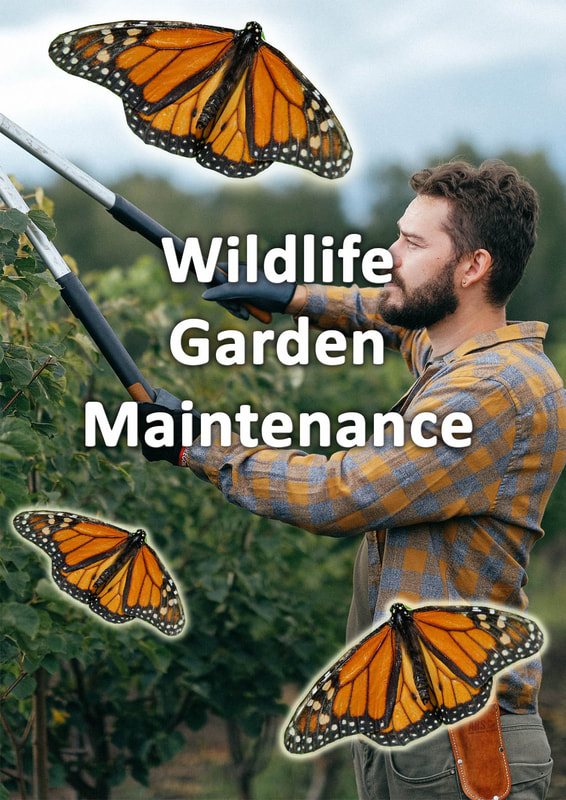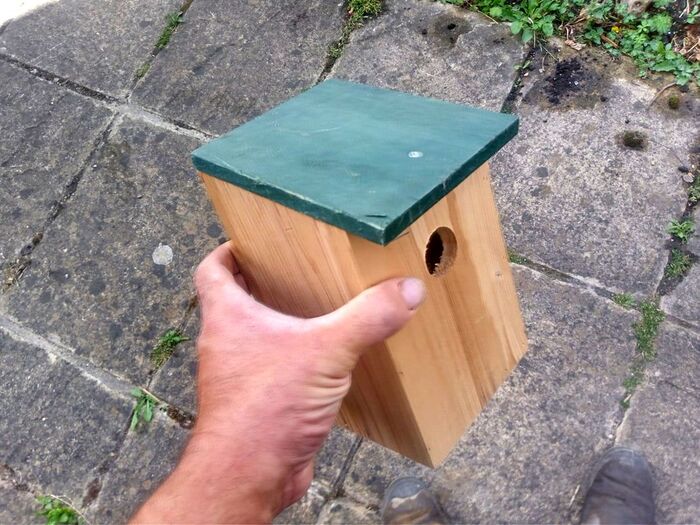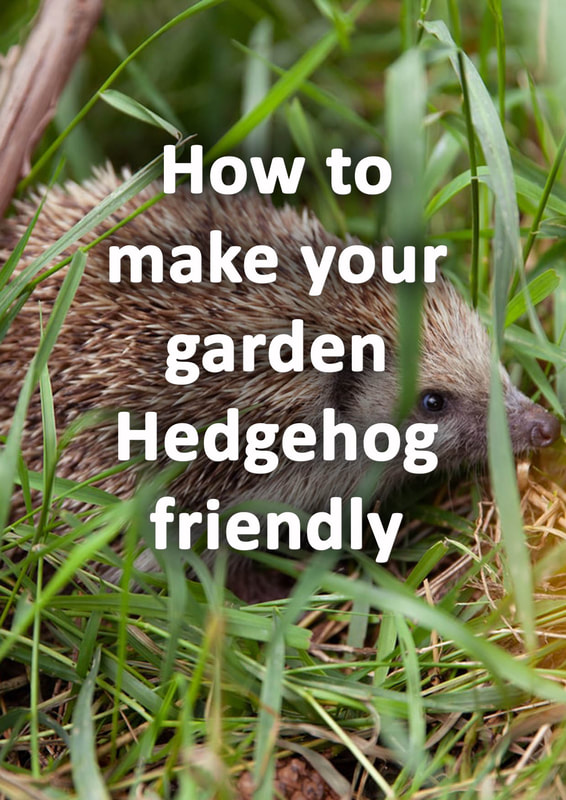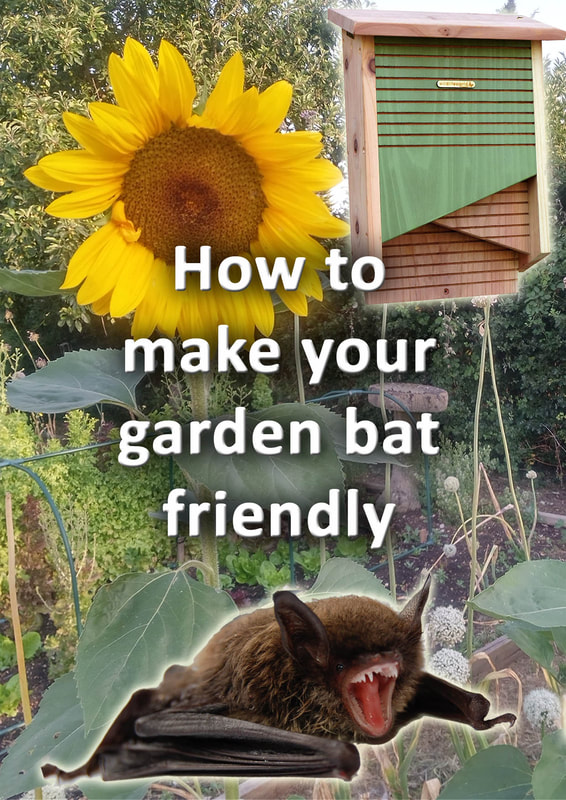|
This article contains affiliate links
Wildlife garden maintenanceIt is very easy to think that wildlife gardens are best left to their own devices. However in order to keep your wildlife in top condition it will require some maintenance tasks. Wildlife garden maintenance is carried out at a much lower frequency to regular garden maintenance. Traditional maintenance aims to keep gardens refined and in good order. Wildlife garden maintenance is aimed more at managing wildlife habitats. This requires preventing the encroachment of one habitat type onto another. It also ensures seasonal regeneration of vegetation for specific habitats. For example, wildflower meadows require seasonal cutting or grazing. This is so natural succession does not occur eventually turning meadows into scrub and then eventually woodland. In this article we list and describe seasonal, wildlife garden, maintenance tasks to keep your habitats at their best. How do you maintain a wildlife garden?
Maintaining wildlife gardens is more about managing habitats than suppressing plant growth. Instead of keeping a garden trimmed within neat and tidy parameters you are continuously enhancing habitat value. This involves more seasonal processes to help regenerate beneficial vegetation. Cutting and pruning is focused at preventing one habitat from dominating another or encroachment onto paths and boundaries. All seasonal management tasks will be carried out at a time not to disturb breeding or hibernation. As wildlife gardens are not expansive wilderness their main function is to encourage as many wild species as possible. This requires maintaining various habitats within an unnaturally small area. Therefore seasonal maintenance and management must be implemented. This keeps wildlife gardens in their very best condition for both people and wildlife. 15 wildlife garden maintenance jobs
1. Clear out wildlife ponds
Wildlife ponds are one of the most vital garden habitats for wildlife. Although dense, aquatic vegetation provides perfect places for pond life to hide and breed it can become overgrown. Too much pond weed and excessive, marginal, growth can lead to a lack of sunlight and oxygen. This can encourage stagnant conditions which is detrimental to most wildlife. Every couple of years it is good to have a good clear out of excess vegetation. It is also a good idea to gently remove silt build up from the depths of the pond. This is best undertaken in autumn to minimise the risk of disturbing summer breeding or winter hibernation. 2. Coppice and pollard trees & shrubs
Coppicing and pollarding is a method of successional tree and shrub pruning. Historically cutting was undertaken for the harvest of long, thin, timber, poles for tool and charcoal making. Such cutting would allow sunlight back to the woodland and scrubland floor invigorating wild plant communities. This seasonal cutting also causes much less disturbance to wildlife. Consequently it is common to come across much coppicing within wildlife gardens. Try to coppice in succession so some trees and shrubs are left until subsequent seasons. This helps to maintain bushy canopies while helping sunlight to reach plants at ground level. Long poles can be utilised for build fencing, hibernacula’s, or wildlife dens. 3. Composting
Composting is a great method of recycling green waste within the garden. In wildlife gardens compost heaps can not only recycle nutrients but provide great nesting sites. Harvested vegetation from wildlife gardens is generally bulkier than traditional maintenance practices. Therefore compost heaps can be organised to incorporate plenty of air gaps for animal hibernation and nesting. These compost heaps can be left to gradually decompose over a couple of seasons. Try to only turn compost during the late summer when breeding is over and hibernation has not yet begun. 4. Trim hedges
Most wildlife gardens will have hedges which need to be cut to a reasonable neatness. Therefore it is always advised to trim when bird species are not rearing young. Hedge trimming should be carried out ideally between August and March. Clippings can be composted or utilised as mulch. 5. Clean nesting boxesIf birds are actively nesting in your wildlife gardens nest boxes, it is good to clean them every year. This is best undertaken around October or November time when young birds have left. Some birds use nest boxes to escape winter cold so autumn is the best time to clean them. Remove all the old nesting material and wash the box with boiling water. Make sure the box is allowed to dry out before reclosing it. 6. Top up hibernacula’s
After a few years you may find that hibernacula’s start to degrade or fall apart. Try to top up your hibernating structures at the end of summer. This can be done with autumn leaves or with branches of pruned back shrubs. 7. Cut meadows
Wildflower meadows are cut either once or twice per year. The best time to cut a meadow is around mid July when most wildflowers have set seed. In a perfect world meadows will be cut in alternate sections to leave some shelter undisturbed. However cutting is an important part of meadow management to prevent scrub species from establishing. A few days after cutting rake off the hay, this can be added to hibernacula’s or compost heaps. 8. Till annual meadows
Some wildflower meadows are grown with a focus on annual wildflowers. A good example of these meadows are the famous corn poppy meadows. Corn poppies enjoy colonising disturbed ground which makes the annual ploughing of corn fields favourable. This is why they readily infiltrate agricultural land. If you have an annual meadow in your wildlife garden till it every autumn or spring. 9 Top up feeders
Most wildlife gardens will maintain feeders or feeding stations especially during the winter. Many species of bird do come to rely on regularly topped up feeders. Therefore it is always a good idea to make sure you have ample supplies during winter. 10. Collect seeds
If you have established a good diversity of wild plants in your garden collecting seeds is a good idea. These can be sown for extra plug plants during the spring time. Alternatively these can be given to friends or sprinkled over wildflower meadows. 11. Top up bird baths
The importance of bird baths to provide fresh water for birds cannot be underestimated. If you do not have a bird bath in your garden they are a worthwhile investment. If you do, they can dry out quickly in hot weather so keep them topped up during summer. Birds also need fresh water in the winter so try to break up bathes which have iced up. 12. Clear out dead perennial plants
At the end of the growing season many perennial plants growth will start to die. This can either be left to stand for the winter or cleared. Small insects do use the hollow stems of these plants to hibernate. If you do clear them away, try to add them to compost heaps or hibernacula’s. 13. Cut back encroaching vegetation
Although dense vegetation is often welcomed in wildlife gardens, encroaching vegetation should be cut back. This is particularly so on pathways and between varying habitats. Such cutting can help to maintain defined areas and spaces with no potential hazards. 14. Check condition of boundaries
It is common for wildlife gardens to become quite wild in some areas. This is especially so at the rear of borders or against walls and fences. It is a good idea every year to keep a close eye on the condition of all boundary walls and fences. Make sure no aggressive climbers like ivy are weakening structures or getting too much of a foot hold. 15. Weed out unwanted saplingsIt is important that you keep an eye on any unwanted saplings which are seeding within the wildlife garden. It is surprising just how quickly a small stem can turn into a small tree in a couple of seasons. Go along all your boundaries and borders and make sure aggressive tree saplings are not getting established. The most typical menaces are windblown Sycamore and Ash saplings. Wildlife garden maintenance company services
Our wildlife garden company are specialists in wildlife garden maintenance and habitat management. If you are interested in not only maintaining your wildlife sites but enhancing their habitat value, please contact us. Our wildlife maintenance services typically operate in seasonal blocks once in early spring and once in late summer. Please email our director Paul to arrange a site visit. Our wildlife garden services include:
Below we have linked to some of our other wildlife garden articles.
Useful links
|
The Author
|
Landscaping services across Buckinghamshire, Amersham, Aylesbury & High Wycombe
Hyde Heath, Amersham, Buckinghamshire |
|












































